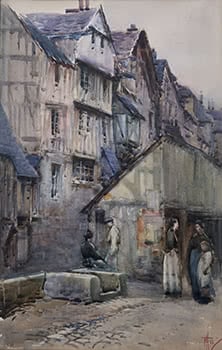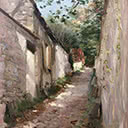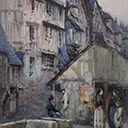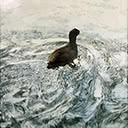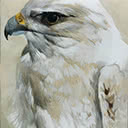Caudebec-en-Caux
50.4 x 32 cm
est. $45,000 - 65,000
PROVENANCE
Collection of Dame Kiri Te Kanawa
International Art Centre, c. 1980
After spending only three months in England in 1901, Frances Hodgkins set out for France, joining the Irish artist Norman Garstin and his wife Augusta and their students at Caudebec-en-Caux, a small town nestling against a steep hill on the north bank of the Seine in Normandy. Garstin had close links to the Newlyn School of Painters, whose practice of painting en plein air was familiar to Hodgkins, having painted out of doors with her father William Hodgkins and sister Isabel in Dunedin. After viewing her work, Garstin insisted that there was nothing he could teach her; rather, she should work alongside the group in her own way. She stayed at the same hotel as the Garstins, along with fellow New Zealand artist Dorothy Kate Richmond and one or two of the wider group, describing her experiences to the 'little mother' in New Zealand; This is a charming spot full of quaint old streets & buildings and subjects in plenty for every day in the year. . . We rise betimes and are out by 6.30, work till midday then back to dejeuner, a comprehensive meal consisting of many courses mostly vegetables & very under done meat, puddings never and copious libations of cider. This is a great cider district and the inhabitants get gloriously drunk, after dejeuner we rest till 3, when we all meet in a large room & have afternoon tea and criticise each other's work, then out again for evening effects. . . [https://completefranceshodgkins. com/objects/29203/letter-from-frances-hodgkinsto- rachel-hodgkins 14 July 1901] Caudebec prides itself on its enormous Gothic cathedral. Unlike numerous artists who recorded its delicate traceries as a backdrop to the bustle of the market in the square beyond, Hodgkins preferred the quieter, narrow streets leading into the main square. Their tall half-timbered houses, with their contrasting stripes of wattle and daub, allowed Hodgkins to focus on compositions that drew the eye skyward while the inclusion of locals making their way back and forth enlivened her scenes. Each time she painted a scene from a different vantage point, experimenting with the changes in perspective. It is in Dame Kiri Te Kanawa's work that we have what appears to be the accumulation of Hodgkins' studies, as if the other watercolours were practice scales for the final musical tour de force. Here our eye is led first into the open foreground, anchored by a strong diagonal of a wall on the left, meeting with what appears to be a small lavoir or washing trough, before continuing on briefly. Its smooth surface provides a resting place for a seated woman engaged in conversation with a workman. Our view is then cut off by a small building, its upper surface rapidly delineated in both straight and curving lathes, separating its sections of pale plaster. The wall stands parallel to the line tall buildings on the left, their ancient facades leaning at odd angles created by the passage of time, each floor punctuated by tiny clusters of windows. The zigzagging roofs and narrow chimney pots draw our eye into the far distance on the right. Hodgkins has used considered, broad brushstrokes in much of the painting, reverting to a fine brush and using its point to block in the outline of the figures, and drawing it across the paper to outline the cobble While she has paid considerable attention to capturing the eccentric individuality of each structure, they serve as a theatrical backdrop for what really interests her most. In the open space in the foreground on the right, Hodgkins has depicted a young boy in a white smock, hand on hip, waiting while his mother's face turns away from us to speak to the woman standing beside her. Her arm rests behind his back, as if she senses his impatience to be off. Attention should also be paid to the wall which serves as an immediate backdrop to both groups, for while the figures on the right have what appear to be dark wooden doors behind them, in the gap between the group there is a warm passage of warm ochre tones, suggesting an open door leading into a warmly lit room. Her time in Caudebec-en-Caux made Hodgkins determined to make her name as a professional artist; 'This kind of life quite unfits one for a colonial hereafter - everything is given up to painting we think & talk of nothing else . . . I feel as if I was possessed by a painting devil which is devouring me body and soul & claims all my brains & energy . . https://completefranceshodgkins.com/ objects/29205/letter-from-frances-hodgkins-torachel- hodgkins Damaged by bombing during WWII, Hodgkins' watercolour of Caudebec stands, not just as a dynamic study of its timbered streets and vibrant peasant life but a reminder of the town's historical integrity.
MARY KISLER

